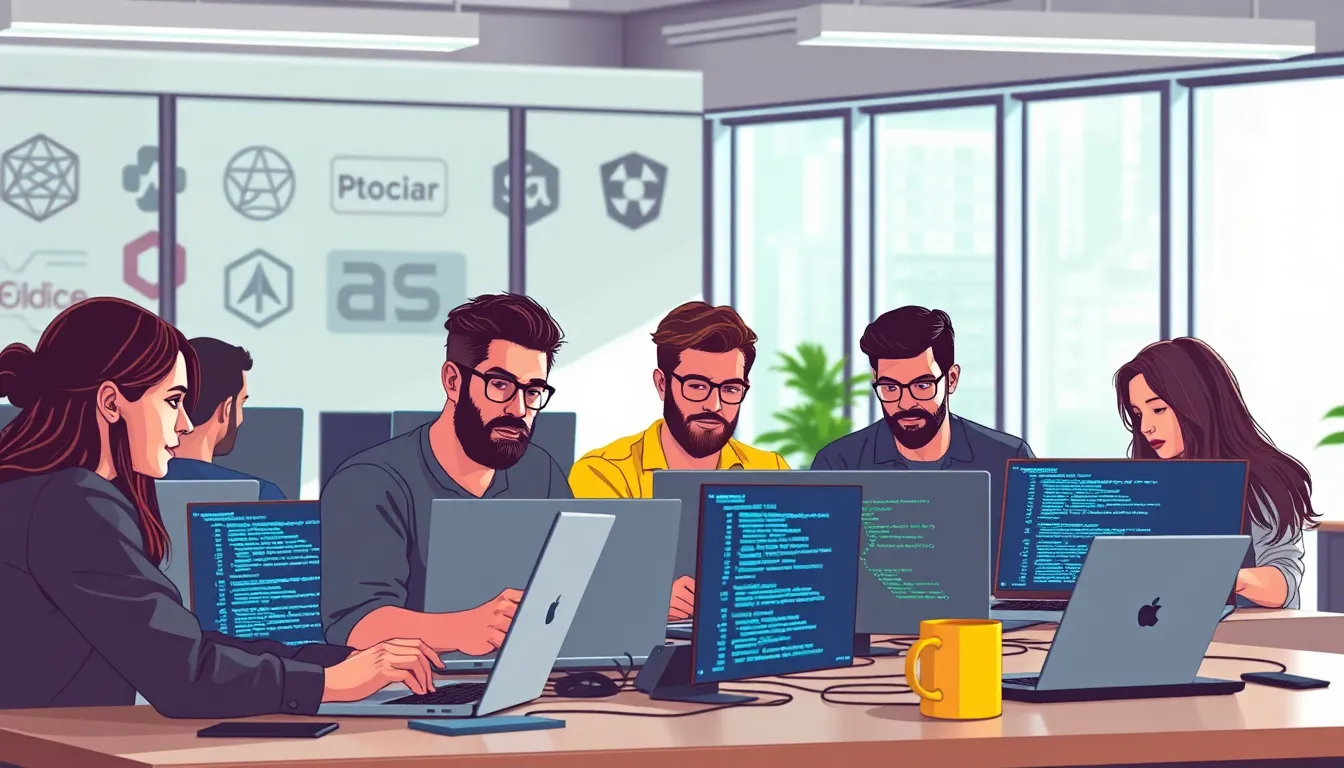Imagine a world where traffic lights know when to change based on real-time traffic flow, or where public services are just a tap away on your smartphone. Welcome to the age of the Internet of Things (IoT) in government. It’s not just about smart fridges reminding you to buy milk anymore; it’s about making government operations more efficient, transparent, and responsive to citizens’ needs.
Table of Contents
ToggleOverview of IoT Applications in Government
The Internet of Things (IoT) revolutionizes government functions by integrating smart devices into public services, increasing operational efficiency and fostering citizen engagement.
Definition of IoT
The Internet of Things refers to a system where interconnected devices communicate and share data over the internet. These devices, equipped with sensors and software, collect and analyze information without human intervention. Examples include traffic sensors, smart meters, and health monitoring devices. Each device’s real-time data sharing contributes to better decision-making processes in government agencies. This interconnected network enables officials to monitor, control, and optimize municipal services effectively.
Importance of IoT in Government
IoT plays a crucial role in improving public services’ efficiency and transparency. By utilizing real-time data, city planners enhance traffic management, leading to reduced congestion and improved air quality. Furthermore, IoT promotes citizen engagement through applications that allow residents to report issues or access government services easily. Increased public safety also comes from deploying smart surveillance and emergency response systems. Such advancements enable government agencies to respond proactively to infrastructure needs and community concerns while optimizing resource allocation.
Smart Cities and Urban Management

IoT applications in smart cities redefine urban management through efficient resource allocation and enhanced public services. These technologies drive smarter decision-making while improving overall quality of life.
Traffic Management Systems
Traffic management systems utilize IoT sensors to monitor vehicle flow and congestion in real-time. Smart traffic lights adjust timing based on current conditions, reducing wait times for drivers. Integration of data from various sources, like GPS devices or mobile apps, allows for accurate forecasting of traffic patterns. Cities can deploy strategies to improve traffic flow, minimize emissions, and enhance road safety. Data-driven insights empower agencies to optimize public transport routes, increasing efficiency for commuters. Deploying such systems reduces congestion and promotes sustainable urban mobility.
Waste Management Solutions
Waste management solutions leverage IoT devices for efficient collection and disposal of waste. Smart bins equipped with sensors track fill levels and alert waste management services when they’re ready for collection. This optimization cuts down unnecessary collection trips, saving fuel and reducing operational costs. Cities adopting these technologies report improved recycling rates due to better tracking of waste types. Real-time data enables municipalities to analyze waste generation trends, tailoring services to community needs. Overall, IoT enhances cleanliness and sustainability in urban areas by streamlining waste management processes.
Public Safety and Security
IoT technologies play a crucial role in enhancing public safety and security by improving surveillance and monitoring systems, as well as emergency response capabilities. Governments increasingly rely on these innovations to safeguard citizens effectively.
Surveillance and Monitoring Systems
Surveillance systems equipped with IoT devices provide real-time monitoring of urban areas. Cameras with embedded sensors capture data, enabling law enforcement to respond quickly to incidents. IoT technology enhances video analytics, allowing for the detection of unusual activities, which aids in crime prevention. Integration with smart lighting improves visibility in public spaces, contributing to safer neighborhoods. Data from these systems supports proactive policing strategies, establishing a more secure environment for communities.
Emergency Response and Disaster Management
Emergency response systems using IoT enable faster action during crises. Sensors placed in various locations monitor environmental changes and detect hazards like floods, fires, or chemical spills. Data from these sensors triggers alerts to emergency services, allowing for swift mobilization. Smart technologies streamline communication between agencies, reducing response times significantly. Governments can deploy resources efficiently, ensuring the safety of citizens during emergencies. Enhanced situational awareness leads to better decision-making in disaster management scenarios.
Healthcare Services Enhancement
IoT technology significantly enhances healthcare services, improving patient outcomes and optimizing resource management in medical settings. Through innovative applications, government agencies streamline processes and provide better care.
Remote Patient Monitoring
Remote patient monitoring facilitates continuous health assessments by utilizing connected devices. These devices gather real-time data on vital signs, enabling healthcare providers to track patients’ conditions from a distance. Chronic illness management sees improved patient engagement and adherence to treatment plans as individuals receive timely feedback. Personalized care becomes more accessible since healthcare professionals can intervene sooner when necessary, reducing hospital readmissions. Cost-efficient solutions ensure patients receive appropriate care while minimizing strain on healthcare facilities.
Data Management in Health Facilities
Data management in health facilities benefits from IoT integration by enabling seamless data sharing. Smart devices collect and transmit patient information, enhancing decision-making processes for healthcare professionals. Real-time analytics support efficient management of resources such as medication inventory and staffing levels. Interoperability across various systems ensures comprehensive patient records are easily accessible, improving coordination of care. Enhanced data security measures protect sensitive information while allowing relevant access to authorized personnel. By focusing on data-driven strategies, healthcare facilities become more responsive to patient needs.
Environmental Monitoring
Environmental monitoring through IoT applications plays a crucial role in enhancing government responses to ecological challenges. By utilizing connected devices, governments can gather real-time data about various environmental parameters.
Air Quality Management
Air quality management benefits significantly from IoT technology. Sensors can measure pollutants such as particulate matter and nitrogen dioxide, providing accurate readings. Governments use this data to ensure compliance with environmental standards and health regulations. Additionally, cities can take proactive measures to reduce pollution during peak levels, advising citizens on air quality and promoting healthier lifestyles. Real-time monitoring allows for faster responses to hazardous conditions, enhancing public health.
Water Resource Monitoring
Water resource monitoring becomes more effective with IoT integration. Sensors placed in streams and reservoirs continuously transmit data on water quality and levels. Governments analyze this information to manage water supply efficiently and detect contamination swiftly. Automated alerts can be triggered whenever contaminants are detected, ensuring quick action to prevent public health risks. Furthermore, this technology supports conservation efforts by accurately measuring usage patterns and detecting leaks, leading to better management of precious water resources.
Challenges and Considerations
IoT applications in government face notable challenges that impact their effectiveness and adoption. Both security and privacy concerns require careful attention.
Security and Privacy Issues
Security threats emerge as a significant concern with IoT integration. Many devices lack robust security features, exposing sensitive data to potential breaches. Privacy implications arise from the extensive data collection performed by IoT devices, which raises questions about how information is stored and used. Government agencies must prioritize data protection to maintain public trust. Implementing strong encryption measures protects data transmissions. Following regulations such as GDPR ensures compliance with privacy laws. Continuous monitoring also identifies vulnerabilities, minimizing the risk of unauthorized access.
Implementation Barriers
Implementation barriers hinder the smooth integration of IoT technologies in government. High initial costs deter many agencies from adopting these innovations, especially in the current budget constraints. Furthermore, lack of standardized protocols complicates interoperability between devices. Technical expertise often remains limited, as agencies might struggle to find qualified personnel familiar with IoT systems. Change management processes can also slow down deployment, as existing workflows must adapt to new technologies. Ensuring adequate infrastructure and support will facilitate more effective implementation of IoT applications in public services.
The integration of IoT in government is paving the way for smarter and more efficient public services. By leveraging interconnected devices, government agencies can enhance decision-making and responsiveness to community needs. The advancements in traffic management, public safety, and healthcare demonstrate the transformative potential of IoT technologies.
While challenges like security and privacy concerns remain, the benefits of IoT applications far outweigh the hurdles. As governments continue to adopt these technologies, they’ll not only improve operational efficiency but also foster greater citizen engagement and trust. The future of public service is bright with IoT at its core, driving innovation and sustainable practices for communities everywhere.






